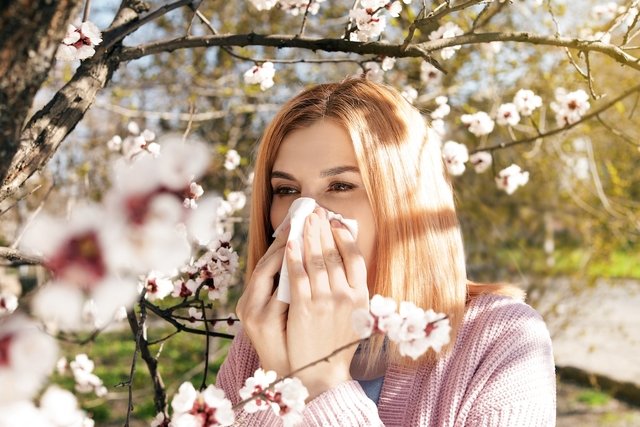“Allergic flu” is a popular term used to describe the symptoms of allergic rhinitis, such as a runny or stuffy nose, constant sneezing, or itchy nose and eyes.
Unlike the flu, which is caused by viruses, “allergic flu” is caused by allergies to substances, such as dust, animal dander or pollen, for example, and is more common during spring or autumn.
The treatment of “allergic flu” is carried out by an otolaryngologist or allergist, who may recommend the use of medication to alleviate symptoms, in addition to it being important to avoid contact with allergenic substances.

Allergic flu symptoms
The main symptoms of “allergic flu” or allergic rhinitis are:
- Itchy eyes and nose;
- Throat irritation;
- Watery eyes;
- Runny or stuffy nose;
- Constant sneezing;
- Dry and persistent cough.
Generally, these symptoms appear immediately, right after contact with a plant or inhalation of dust, for example. Learn about other symptoms of allergic rhinitis and how to confirm it.
It is important to consult an otolaryngologist or allergist whenever “allergic flu” appears, so that it can be evaluated and the most appropriate treatment can be indicated.
How to confirm the diagnosis
The diagnosis of “allergic flu” is made by an otorhinolaryngologist or allergist, through the evaluation of symptoms, health and allergy history, in addition to a physical examination.
Furthermore, the doctor may recommend carrying out an allergy test to identify the substance to which you are allergic, thus being able to indicate the most appropriate treatment. See how the allergy test is done.
If you would like an evaluation with an otorhinolaryngologist, schedule an appointment near your region:
Taking care of your health has never been easier!
How to differentiate flu from allergic rhinitis
Unlike allergic rhinitis, which is characterized by symptoms more localized to the face, the flu can cause more generalized symptoms such as fever, general malaise and body aches. Know how to identify flu symptoms.
Furthermore, flu symptoms tend to last 7 to 10 days, while rhinitis symptoms can persist as long as there is exposure to a certain allergen in the air.
As the symptoms of flu and rhinitis are very similar, it is common for them to be confused. However, flu is caused by a virus, while rhinitis has an allergic cause, requiring different treatments.
Possible causes
“Allergic flu” is caused by an exaggerated reaction of the immune system to allergenic substances, releasing histamine into the body, resulting in symptoms.
The main allergens that can cause “allergic flu” are:
- Mite, dust or mold;
- Pollen;
- Animal hair, saliva or urine;
- Climate changes;
- Strong odors, such as perfumes or cleaning products;
- Cigarette smoke.
“Allergic flu” is not contagious, that is, it is not transmitted from person to person, and may occur more frequently in children of allergic parents.
How the treatment is carried out
The treatment of “allergic flu” or allergic rhinitis must be carried out under the guidance of an otorhinolaryngologist or allergist, who may recommend anti-allergy medications such as desloratadine or cetirizine, to help alleviate symptoms.
In addition, the doctor may also recommend the use of nasal corticosteroids, as they quickly relieve the symptoms of “allergic flu”. Check out other remedies for allergic rhinitis.
In cases where there was no improvement with medication and for those who cannot avoid contact with the allergen, the vaccine is an option and may be recommended by the doctor after carrying out the allergy test. Learn more about the allergy vaccine.
Home treatment for allergic flu
Some teas, such as eucalyptus tea, are good alternatives to treat “allergic flu”, as they facilitate the exit of nasal secretions, relieving symptoms, and can be used to complement the treatment recommended by the doctor.
Check out other home remedies to alleviate the symptoms of “allergic flu”.
How to prevent “allergic flu” attacks
Attacks of “allergic flu” can be alleviated with some measures in the environment in which you live, such as:
- Avoid carpets, rugs, stuffed animals and lightly used clothes, to avoid dust accumulation;
- Change bed linen weekly and place the mattress to air in the sun;
- Keep the environment airy and ventilated whenever possible with open windows;
- Clean the house and furniture preferably with a damp cloth;
- Avoid contact with pets if it is observed that they are causing the symptoms;
- Avoid products with a strong smellsuch as cleaning products, paints, perfumes and insecticides;
- Avoid contact with cigarette smoke.
Additionally, it is important to avoid being outdoors on windy days, especially in spring and autumn.
Bibliography
- AKHOURI, S.; HOUSE, S. A. IN: STATPEARLS (INTERNET). TREASURE ISLAND (FL): STATPEARLS PUBLISHING. Allergic Rhinitis. 2022. Available at: <https://www.ncbi.nlm.nih.gov/books/NBK538186/>. Accessed on May 8, 2023
- SIDDIQUI, ZA; et al. Allergic rhinitis: diagnosis and management. Br J Hosp Med (Lond). 83. 2; 1-9, 2022
- SCHULER, I. C. F.; MONTEJO, J. M. Allergic Rhinitis in Children and Adolescents. Immunol Allergy Clin North Am. 41. 4; 613-625, 2021
- IAPO MANUAL OF PEDIATRIC OTORHINOLARYNGOLOGY. Specific immunotherapy with allergens in the treatment of allergic rhinitis. Available at: <http://www.iapo.org.br/manuals/VI_Manual_br_Imunoterapia%20especifica.pdf>. Accessed on March 20, 2020
- RUBINI, Norma de PM et al. Practical guide on environmental control for patients with allergic rhinitis. Arq Asthma Allerg Immunol. Vol.1, n.1. 7-22, 2017
- FOIM; Angela BF et. at the.. Nasofibroscopy for the diagnosis of allergic rhinitis in children and adolescents. Brazilian Journal of Allergy and Immunopathology. 24. 6; 220-228, 2001

Sign up for our newsletter and stay up to date with exclusive news
that can transform your routine!
Warning: Undefined array key "title" in /home/storelat/public_html/wp-content/plugins/link-whisper-premium/templates/frontend/related-posts.php on line 12
Warning: Undefined array key "title_tag" in /home/storelat/public_html/wp-content/plugins/link-whisper-premium/templates/frontend/related-posts.php on line 13




